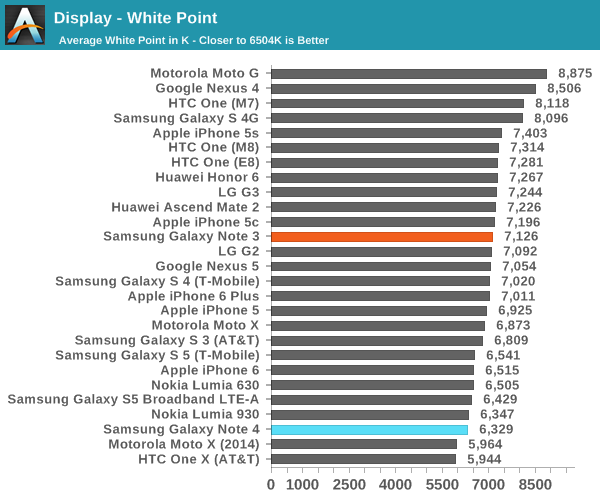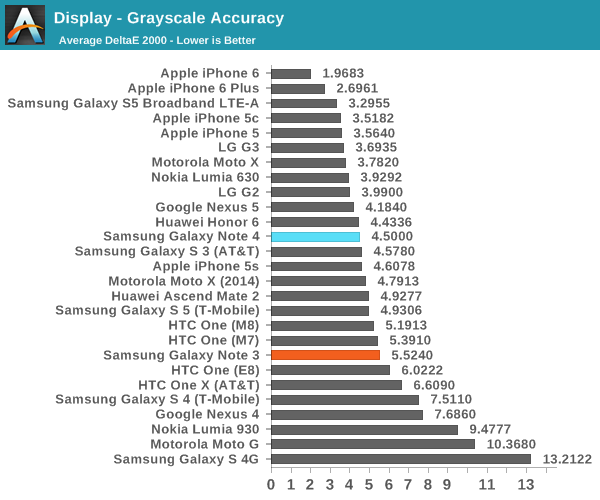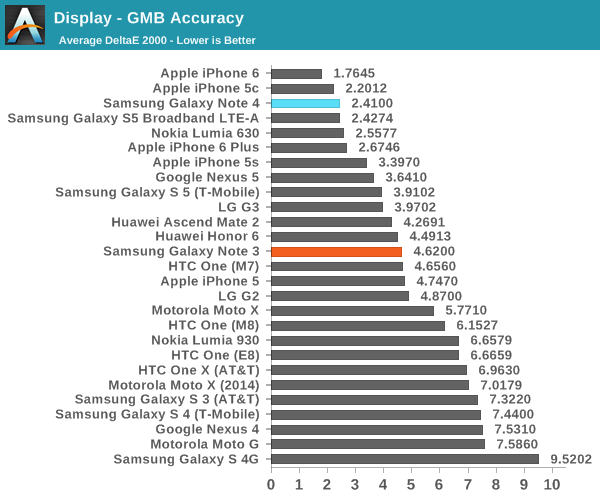The Samsung Galaxy Note 4 Review
by Joshua Ho on October 15, 2014 9:00 AM EST- Posted in
- Smartphones
- Samsung
- Android
- Mobile
- Galaxy Note 4
Display
With the advent of the modern smartphone, the display became one of the most important aspects of the entire experience as it was the only method of interacting with the device. To this end, Samsung has equipped the Galaxy Note 4 with their latest generation AMOLED panel, which has a higher resolution 1440p display, although this is achieved with a PenTile subpixel layout that makes total subpixel density lower than a conventional RGB stripe, so true subpixel density increases around 20% when compared to an RGB stripe 1080p panel. For reference, going from an RGB stripe 1080p panel to a 1440p panel of the same subpixel stripe would have a density increase closer to 80%.
In practice, the visible resolution varies somewhere between the “worst case” where the eye can see the true subpixel density and the best case where the display appears to be an RGB stripe 1440p display. If I look closely it’s still possible to see a fringing patterns in certain cases. Other than these minor cases, the Galaxy Note 4’s display has more than enough resolution for a smartphone use case. This is noticeably better than what I see with the iPhone 6 Plus, although in casual use it’s unlikely that these resolution differences will actually matter in most cases. I definitely think that there will be a visible difference for VR, although even the Galaxy Note 4’s display lacks sufficient resolution to have a “perfect” display in that scenario.
However, resolution is a relatively simple metric to look at. In order to better test the display we must look at other key metrics. In order to do this, we turn to SpectraCal’s CalMAN 5, along with a spectrophotometer for accurate color measurements.

While relatively simple, brightness and contrast are quite important as a display that’s dim or low in contrast will appear to be quite poor. In terms of brightness, we see that Samsung continues to maintain relatively high peak luminance, and a massive improvement when compared to previous generation AMOLED displays. While the normal peak brightness is a bit on the low side, as long as one uses auto-brightness the display’s “boost mode” will be able to activate and reach around 450 nits so in practice sunlight visibility should be more than acceptable. Contrast remains as incredible as it always is with AMOLED displays of this generation, although there still seems to be visible RC delay of some sort as there can be a purple trail effect when pixels transition from an unlit to lit state. I suspect this is mostly unavoidable, and is generally only visible at low brightness.


The next test we’ll look at is grayscale, which can suggest issues with overall tints in the display and issues with gamma. In this area, we see that the display is definitely quite good in overall gamma but unfortunately there’s a bit of a green tint here which causes a regression when compared to the Galaxy S5 LTE-A Broadband. This is really only visible on some certain percentages of gray but it would be an area where some improvement is needed.

While grayscale is one aspect of the display, it’s also important to look at color overall. One of the first tests for color is the saturation sweep, where the Note 4’s display performs admirably. At this point, there’s really not much to point out for improvement as the dE2000 average is low enough that one won’t notice any issues with color accuracy in Basic mode.

Similarly, the display does a fantastic job in the Gretag Macbeth ColorChecker. It should be possible to get a good idea of what a photo will look like on other displays and other similarly color-sensitive work on the Note 4. Samsung has also included other modes for those that want more vivid or otherwise more saturated color, which is of great benefit for those interested in such a color profile. The one potential issue here is that there is color shifting when altering viewing angles. In comparison to the Note 3, the Note 4 has a far better display. As-is, the state of AMOLED seems to be in a dead heat with LCD now as both seem to have their own trade-offs. However, we may soon see a shift as Samsung’s AMOLED becomes indisputably better than even the best LCDs.













195 Comments
View All Comments
akdj - Wednesday, November 12, 2014 - link
I'm sure I'm being ignorant here, but how do I 'access' that satellite display?'Best option....the one built into Qualcomm's own modem...'
Is that an option already 'built in' or an app downloaded from the Play Store? I owned the original Note and couldn't get out of it quick ebough! Contract expired, I went in to look for my next dedicated business line (the original Note's responsibilities;)) --- & about thirty seconds with the Note 3 I caved. Bought it and I've enjoyed it daily without issue for almost 14 months now. It's paid off in two, and this review leaves me curious. Especially the display & it's 'relative' efficiency maintained in essentially the same package and by doubling it's resolution.
Something to be said for these sharper, HiDPI displays ...especially for those of us with 'aging eyes' ;) --- I couldn't be happier with this resolution push, and the good riddance to 3D!
Sorry, TL/DR
What is he using as an app for that screenshot in the GPS lock tool?
Thanks
NeatOman - Wednesday, October 15, 2014 - link
Curious to see the difference in battery life between 2.4Ghz Wireless N and Wireless AC, I've noticed a significant increase with my Nexus 5, and of course it was said the rest of the tests will be up later so that's cool.skinygeek - Wednesday, October 15, 2014 - link
No Word about the Exynos Variant? I was expecting a detailed analysis of the Exynos 5433. Was the Exynos version not provided to you for review?Laxaa - Wednesday, October 15, 2014 - link
I think the Exynos variant is the international one. I guess Samsung didn't send them one as it won't be out in the US.skinygeek - Wednesday, October 15, 2014 - link
Then they should have bought it . How hard it is to get an international variant of a device. There are websites which ship you these things. I don't expect such things from other websites, but Exynos 5433 marks a new Chapter in SOC's for Android phones for being the first high end A57+A53 CPU and i was expecting Anandtech to review hat SOC given their expertise in such things .Laxaa - Wednesday, October 15, 2014 - link
Hopefully, a comparison will be made at a later date if they get a hold of such a device. I agree that it will be interesting to see how if fares.extide - Wednesday, October 15, 2014 - link
Even though it's A57/A53 it is still locked down to 32-bit only :(gunsman - Wednesday, October 15, 2014 - link
but it will allow us to better quantify the addition of ARMv8 and 64 bit once ARMv8 enabled A57/A53 comes outKPOM - Wednesday, October 15, 2014 - link
Anandtech is still a U.S.-oriented site. And the 805 will be sold in more markets. There is plenty of data out there on the Exynos' performance. It isn't that good, which is why Samsung used the 805 in its most lucrative markets such as the US, EU, and Japan.heartinpiece - Thursday, October 16, 2014 - link
I disagree with the performance part, Some benchmarks show that the exynos 5433 surpasses the 805. The only reason 805 is used, (as far as I know) is the modem chips.a simple comparison:
805 Geekbench: of note 4
http://browser.primatelabs.com/geekbench3/780401
exynos 5433 geekbench of note4
http://browser.primatelabs.com/geekbench3/775316
Now i don't mean to say this benchmark shows the whole story.
But I am saying that 'it is that better'
Anandtech is a US oriented site, however for first A57+A53 SoC, it is well worth the review.